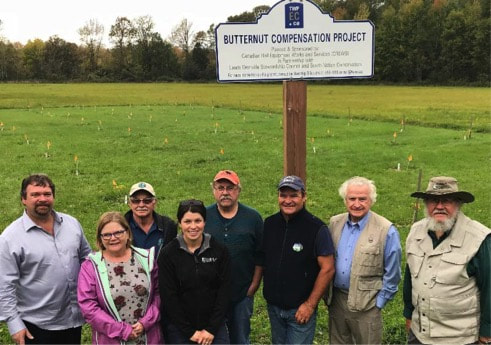
This butternut compensation project came about as a result of a new industry being located in Edwardsburgh Cardinal Township near the Windmill east of Prescott.
In the process of the new industry obtaining an environmental permit, a number of butternut trees were identified, on this property, which would have be removed to permit the construction of buildings and rail lines.
To compensate for the loss of this endangered species the Township agreed to allow a compensation plot on municipal owned land, for not only the trees being removed by this new industry, but extra trees, as needed in the future.
Photo above: Standing in front of the grove are, from left, CREWS owner Clayton Jones, Township CAO/Clerk Deb McKinstry, Leeds-Grenville Stewardship Council's Dave Robertson, South Nation Forestry Technician Cheyene Brunet, Cliff Rogers and Jack Henry (Stewardship Council), Edwardsburgh Cardinal Mayor Pat Sayeau and South Nation representative Lawrence Levere.
As a result, a butternut health assessment permit was obtained from the Ministry of Natural Resources and a multi-year Memorandum of Understanding developed between The Township of Edwardsburgh Cardinal, South Nation Conservation Authority and Leeds Grenville Stewardship Council for the planting and maintenance of butternut trees at the Blair Road site.
Thirty-nine butternut trees were planted along with forty red oak companion trees in alternating rows spaced three meters apart.
The property was mowed weekly from mid April to early October. Due to the wet summer in 2017 the gator watering system was not required.
At the official opening in October it was determined that the butternut trees had a 95% survival rate.
2019 was year two of the maintenance of the plot which included mowing watering and maintenance by LGSC. Leeds Grenville Stewardship Council members David Robertson, Cliff Rogers and Jack Henry participated in maintaining the plot during 2019.
The survival at the end of year 2 was 82% (32 alive, 7 dead). The 7 dead trees will be refilled in the spring of 2019 to boost the site back up to 100% as required each year until the end of the 5th growing season.
A Year 3 survival assessment was completed on August 30th last fall and found the overall survival to be 82%, meaning 32 alive trees and 7 dead.
The 7 dead trees will be replaced this spring as per the requirement to refill the site each year.
In the process of the new industry obtaining an environmental permit, a number of butternut trees were identified, on this property, which would have be removed to permit the construction of buildings and rail lines.
To compensate for the loss of this endangered species the Township agreed to allow a compensation plot on municipal owned land, for not only the trees being removed by this new industry, but extra trees, as needed in the future.
Photo above: Standing in front of the grove are, from left, CREWS owner Clayton Jones, Township CAO/Clerk Deb McKinstry, Leeds-Grenville Stewardship Council's Dave Robertson, South Nation Forestry Technician Cheyene Brunet, Cliff Rogers and Jack Henry (Stewardship Council), Edwardsburgh Cardinal Mayor Pat Sayeau and South Nation representative Lawrence Levere.
As a result, a butternut health assessment permit was obtained from the Ministry of Natural Resources and a multi-year Memorandum of Understanding developed between The Township of Edwardsburgh Cardinal, South Nation Conservation Authority and Leeds Grenville Stewardship Council for the planting and maintenance of butternut trees at the Blair Road site.
Thirty-nine butternut trees were planted along with forty red oak companion trees in alternating rows spaced three meters apart.
The property was mowed weekly from mid April to early October. Due to the wet summer in 2017 the gator watering system was not required.
At the official opening in October it was determined that the butternut trees had a 95% survival rate.
2019 was year two of the maintenance of the plot which included mowing watering and maintenance by LGSC. Leeds Grenville Stewardship Council members David Robertson, Cliff Rogers and Jack Henry participated in maintaining the plot during 2019.
The survival at the end of year 2 was 82% (32 alive, 7 dead). The 7 dead trees will be refilled in the spring of 2019 to boost the site back up to 100% as required each year until the end of the 5th growing season.
A Year 3 survival assessment was completed on August 30th last fall and found the overall survival to be 82%, meaning 32 alive trees and 7 dead.
The 7 dead trees will be replaced this spring as per the requirement to refill the site each year.